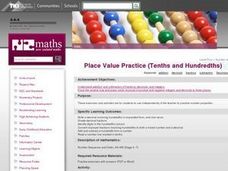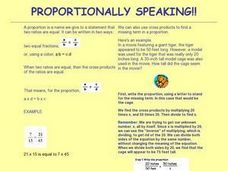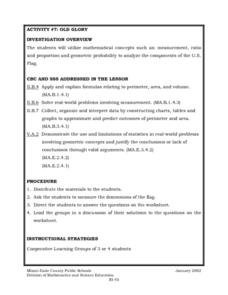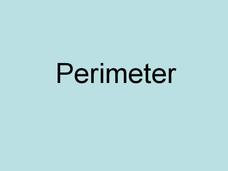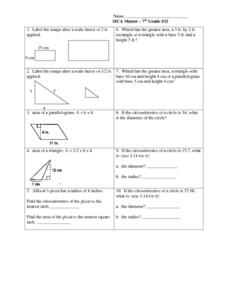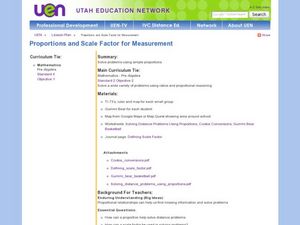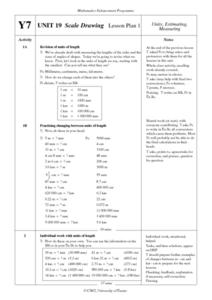Curated OER
Unit 5: Worksheet 3 - Similar Triangles
In this similar triangles worksheet, students use proportions to solve for the missing sides of similar triangles. This two-page worksheet contains 16 multi-step problems.
Curated OER
One Size Fits All, Part 1
Can you tell how tall someone is just by looking at their feet? In this activity, young mathematicians measure their height, arm span, and foot size, graph their findings, and answer questions about how these measurements are related....
Curated OER
Place Value Practice (Tenths and Hundredths)
Math scholars recognize place value and practice writing numbers in different forms, such as expanded notation, decimals, and improper fractions. They complete exercises that include creating models for fractions and decimals and...
Curated OER
Proportionally Speaking!
Pupils are introduced to the concept of proportions. In groups, they practice solving equations and identify the fraction and ratio as well. They complete a worksheet following the steps outlined to them to review the concept.
Curated OER
Worksheet 2: In/Out Table of Returns of Corn Yields
In this function worksheet, students determine the gross price earned per acre of crops planted. They recognize ratios and proportions as they determine the yield of each crop.
Curated OER
Zome System
Get hundreds of interactive activity plans using the Zome Modeling System. Among dozens of lessons, a first exposure to similar triangles can be very visual for the learner. Here, young geometers explore the number of different shapes...
Curated OER
Old Glory
Learners utilize mathematical concepts such as: measurement, ratio and proportion and geometric probability to analyze the components of the U.S. Flag. They collect, organize and interpret data by constructing charts, tables and graphs...
Primary Resources
Ratio and Proportion
A great way to practice ratio and proportion problems. There are three word problems that set the stage, images and table help learners see how each problem is solved. A very useful tool when introducing or reviewing proportions and ratios.
Curated OER
Perimeter
Have your class practice finding the perimeter of several given shapes. This slide show includes a definition and example of how to find perimeter along with several practice problems for the class to solve.
Curated OER
Developing the Concept: Proportions
Students solve problems with proportions. In this proportions lesson, students solve word problems as they learn about how to set up formulas for solving proportions. Students then solve problems using proportions.
Curated OER
Introducing the Concept: Proportions
Students measure distances. In this proportions lesson, students use a map to find how far it is between different cities. Students use their knowledge of measurement, multiplication and fractions to find the distances.
Curated OER
Introducing the Concept: Rates
Sixth graders explore rates as a specific type of ratio, using visual examples of unit rates and unit prices to increase comprehension. They also practice solving problems that are modeled by the instructor. The well-scripted lesson is...
Curated OER
7th Grade Math Worksheet
In this integers activity, 7th graders solve 10 different problems that include various types of integers and graphs. First, they determine the sum of 3 consecutive integers. Then, students find the ratio between 2 areas of similar...
Curated OER
Froot Loops to the Max - 2
In this Froot Loops to the max worksheet, middle schoolers complete and solve 5 problems related to a box of Froot Loops cereal. First, they determine how many of each color is represented in the box of Froot Loops. Then, students...
Curated OER
Fractals Teachers' Notes
When you see a flower or a tree in nature do you see the math? This web resource contains many ideas for using fractals in a math class including Sierpinski’s triangle, Koch's Snowflake, and the Jurassic Park Fractal. Additionally, it...
Curated OER
Ratio Problems Worksheet 3
In this ratios worksheet, students solve word problems containing ratios of pencils, hot dogs, and more. Students complete 5 problems.
Curated OER
Shots, Standings, and Shopping
Rates and ratios can easily be applied to real-world situations. Learners explore a series of websites in order to procure comparable data. They define ratios and rates, view videos, and use the internet to explore how ratios and rates...
Curated OER
Ratios, Unit Rates, and Proportions
Explore the concept of ratios, unit rates, and proportions. Learners convert fractions and percents to decimals. They discuss rates and where they can be found in the real world. A hands-on experiment and numerous flash cards and...
Curated OER
Scale Skills
In this mapping skills worksheet, students read an excerpt that describes three different types of scales and how to calculate distance on a map. They respond to two short answer questions using the map provided on the sheet and to...
Curated OER
Geometry: Area, Scale Factor, Circumference
In this geometry worksheet, students solve 10 problems regarding area, scale factors, and circumference. Students, in 3 of the problems, are given the circumference and asked to work backwards to find missing information.
Curated OER
Proportions and Scale Factor for Measurement
Students explore the concept of proportion. In this proportion instructional activity, students use google maps to find the distance the their school is from home. Students discuss what a scale factor is through teacher led discussion....
Curated OER
Scale Drawing Lesson Plan
Students calculate actual building measurements from a village map using concepts of ratios and scale in this ten lesson mini-unit. They practice measuring angles, multiplying decimals, estimating height and length, and converting metric...
Curated OER
Ratio and Proportion: Basic Operations and Applications
Learners explore example problems dealing with ratios and proportions. Afterward, they read story problems and solve them using ratios and proportions. This four-page worksheet contains six multi-step problems.
Curated OER
Symmetry and Geometric Shapes on Campus
Build on your learners' previous knowledge of geometric shapes and symmetrical figures. Then set them out to take photos of geometric shapes on campus. They assess whether the photos contain symmetry or not.




